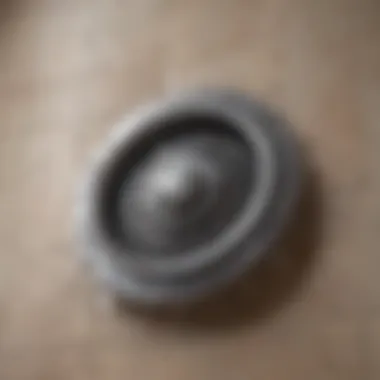Effective Techniques for Hair Removal from Shower Drains


Intro
Hair accumulation in shower drains can lead to frustrating clogs and inefficient drainage. As more people maintain long hair or deal with shedding, this issue becomes prevalent. Understanding the best practices for removing hair from shower drains is crucial for homeowners who aim to preserve the functionality of their bathrooms. This article explores various methods to address hair clogs and offers preventive measures to maintain optimal drainage.
Regular maintenance and prompt action can significantly extend the lifespan of shower systems while promoting cleanliness and efficiency. Achieving a sustainable approach towards shower maintenance is an investment in both time and resources that pays off in the long run.
Understanding the Problem of Hair Accumulation
Hair accumulation in shower drains is a pervasive issue that many homeowners encounter. Understanding this problem is essential for maintaining effective drainage and avoiding more serious plumbing concerns down the line. When hair collects in drains, it can lead to clogs that disrupt the flow of water, causing a range of inconveniences. This section will elaborate on the factors that contribute to hair accumulation and the implications it has on drainage functionality.
Common Causes of Clogs
Several factors contribute to hair clogs in shower drains. The most significant cause is the natural shedding of hair that occurs during showers. As individuals wash and rinse their hair, strands can easily fall out and accumulate in the drain. Additionally, the design of the shower drains can exacerbate this problem. Some drains have narrower openings, making it easier for hair to snag and build up over time.
Another important cause is the use of products such as shampoos, conditioners, and soaps. These products may contain ingredients that can combine with hair to form clumps, making them more difficult to wash away. Furthermore, shedding from pets can also contribute to drain clogs, especially in homes with multiple animals.
Impact on Drainage Functionality
When hair accumulates in the shower drain, it can hinder water drainage, leading to slow-flowing or completely blocked drains. This blockage not only causes inconvenience but can also create an environment conducive to mold growth and unpleasant odors. Water that cannot effectively drain can result in standing water, which may pose health risks if left unaddressed.
In fact, neglecting hair accumulation can lead to more serious plumbing issues that require professional intervention. Regularly monitoring and addressing hair buildup is crucial for maintaining your plumbing systems and ensuring the longevity of your drains.
Understanding the problem of hair accumulation empowers homeowners to take proactive measures. By recognizing the causes and implications, individuals can implement effective strategies to maintain clean and functional shower systems.
Initial Assessment of Your Drain
An initial assessment of your drain is crucial in addressing the issue of hair accumulation effectively. Most homeowners often overlook this step, yet it plays a vital role in preventing future clogs. Identifying the nature and extent of the blockage can inform your approach. It helps in selecting the correct tools and techniques for removal. Neglecting this assessment may lead to using ineffective methods, wasting time and resources.
Focusing on your drain's specific conditions allows for a more tailored and successful unclogging strategy. Additionally, early identification of potential problems can save you from costly repairs down the line. Regular assessments can keep your drainage system functioning efficiently.
Identifying Signs of Clogs
Recognizing signs of clogs early can prevent significant buildup. Some common indicators include:
- Slow Drainage: If water takes longer to go down the drain, it may signal a blockage.
- Unpleasant Odors: A lingering smell can indicate decomposing hair or other materials obstructing the pipe.
- Gurgling Sounds: If you hear strange noises from the drain, it could suggest air trapped by a clog.
- Water Backup: Standing water in the shower suggests a significant clog that needs urgent attention.
Observing these signs can help you intervene before a complete blockage occurs, leading to more severe issues.
Tools Required for Inspection
To effectively assess your drain, certain tools may prove helpful. Here are some essential items:
- Flashlight: A flashlight will aid in inspecting dark areas of the drain for visible blockages.
- Plumbing Snake: This can help probe deeper into the drain to identify obstructions.
- Mirror: A small, handheld mirror may assist in inspecting hard-to-see angles.
- Paper Towels: Use these to clean any debris around the drain area during your inspection.
Having these tools ready can simplify the process and improve your understanding of your drain's condition.
Manual Removal Techniques
Manual removal techniques play a crucial role in effectively addressing hair clogs in shower drains. This section will explore why these methods are significant and what specific elements make them beneficial in resolving hair buildup. Manual interventions often offer a straightforward and cost-effective approach compared to chemical methods or professional services. They provide immediate results while also allowing the individual to assess the state of the drain personally.
The primary advantages of manual removal techniques include:
- Direct Access: Getting hands-on with the clog allows homeowners to observe the nature and extent of the blockage.
- Simplicity: These methods do not require extensive tools or knowledge. Most individuals have primary tools that can be easily used for this purpose.
- Cost-Effectiveness: Unlike chemical solutions or hiring professionals, manual removal involves minimal costs.
- Immediate Feedback: Performing the removal provides instant visually observable results which can be satisfying and reassuring.


While there are many methods for manual removal, two stand out: using your hands and employing tweezers or pliers.
Using Your Hands for Removal
Manually removing hair clogs using your hands can be effective but should be approached with caution. First, remember to use gloves to maintain hygiene, as hair can entangle with residues that are not pleasant or safe to touch. To begin, remove the drain cover, if applicable. At this point, visually inspect the drain for any visible hair buildup.
Insert your fingers gently into the drain and feel around. Often, hair can be pulled out in clumps. It’s important to be patient and methodical; rushing this process can cause you to miss parts of the clog. If necessary, keep a small container nearby to collect the hair as it is removed. This helps in keeping your working area tidy and can prevent any further clogging.
Moreover, be aware that sometimes hair may be deep inside the pipes, which may require a bit more effort to reach. Although using hands might seem rudimentary, it can be quite powerful in resolving minor clogs effectively.
Employing Tweezers or Pliers
When hair clogs are extensive or too deep for manual removal with hands, using tools like tweezers or pliers becomes beneficial. These tools enhance the reach and grip, allowing for more efficient extraction of tangled hair.
Begin by removing the drain cover carefully if it is not already removed. Using long tweezers or pliers, insert the tool into the drain. Adjust your grip to firmly yet cautiously grasp the hair. Pull gently, ensuring you do not cause any damage to the plumbing. The design of these tools allows for accuracy, making it easier to delve deeper into the drain than fingers alone could manage.
Be mindful of the surrounding areas; sharp tools can potentially cause scratches or damage to the drain or pipes. After retrieving hair, also consider the purpose of these methods - to maintain a clean and functional shower system. By using tweezers or pliers effectively, you can restore drainage efficiency and prolong the time needed before needing to address future clogs again.
"Manual methods not only clear the clogs but also give insight into how often maintenance is required."
In summary, manual removal techniques provide an accessible means to maintain shower drains. Both hands and tools like tweezers serve their purpose in ensuring drains remain unclogged, allowing for a smoother bathing experience. Regular use of these methods can minimize the need for more drastic remedies later on.
Utilizing Drain Cleaning Tools
Utilizing drain cleaning tools is essential for effective maintenance and management of your shower drain. These tools are designed to tackle clogs that simple manual methods might not resolve. They provide homeowners with the ability to efficiently remove hair and other debris that can accumulate over time, leading to significant drainage issues.
Proper use of these tools can save time and potentially reduce costly plumbing repairs. Furthermore, understanding the limitations and benefits of each tool can help in selecting the most suitable option for your specific problem.
Plumbing Snakes: A Effective Option
Plumbing snakes are versatile tools designed to penetrate deep into your drain. They can effectively dislodge hair and other build-up, helping restore flow. A snake consists of a long, flexible coil with a handle at one end. You simply insert it into the drain and twist or push to catch debris. This method is advantageous for serious blockages.
When using a plumbing snake, you may consider:
- Length of the Snake: Longer snakes can reach deeper clogs.
- Type of Snake: Choose between manual and powered options based on clog severity.
- Technique: Carefully maneuver the snake to avoid damaging your pipes.
Using a plumber's snake can result in a much clearer drain, allowing water to flow freely again.
Drain Clog Removers: Pros and Cons
Drain clog removers, often found in liquid or gel form, are a common alternative. They contain chemicals aimed at breaking down hair and other organic matter. Here's a balanced view:
Pros:
- Ease of Use: Just pour down the drain and let it sit.
- Effectiveness: Quick action on various types of clogs, depending on the product.
- Accessibility: Widely available in stores and online.
Cons:
- Chemical Exposure: Some cleaners can be hazardous, requiring careful handling.
- Pipe Damage: Frequent use of harsh chemicals may corrode pipes over time.
- Environmental Impact: Many chemicals are not eco-friendly.
"Using the appropriate tool not only resolves the immediate problem but also contributes to the longevity of your plumbing system."
Chemical Solutions for Clog Removal


Chemical solutions play a central role in addressing the issue of hair accumulation in shower drains. These products are valuable for their efficiency and ease of use when it comes to tackling stubborn clogs that resist manual removal techniques. They can save time and provide instant results when used correctly. However, the potential impacts on plumbing and the environment merit careful consideration. Knowing how and when to use such chemicals can contribute to better long-term drain maintenance, while also minimizing potential harm to your plumbing systems and the ecosystem.
Overview of Chemical Drain Cleaners
Chemical drain cleaners typically contain strong agents designed to break down organic material like hair, soap scum, and grease. Common ingredients include sodium hydroxide, sulfuric acid, or enzymes. These components work in different ways to dissolve clogs:
- Alkaline Cleaners: Containing sodium hydroxide, these cleaners create a chemical reaction that generates heat. This heat helps to disintegrate organic matter more quickly.
- Acidic Cleaners: Sulfuric acid cleaners rapidly break down materials but must be handled with extreme caution due to their corrosive nature.
- Enzymatic Cleaners: These are generally more environmentally friendly. They contain bacteria or enzymes that slowly break down waste without harsh chemicals.
Using chemical drain cleaners often involves pouring the product down the drain according to the manufacturer's instructions, waiting for a specific time, then rinsing with hot water. While they offer a quick solution, users must also consider the type of pipes in their homes. Older plumbing can be vulnerable to damage from corrosive chemicals.
Environmental Considerations
When it comes to using chemical drain cleaners, the environment is an important factor. Many traditional cleaners release harmful substances upon application. These substances can travel through the plumbing systems and eventually reach waterways, posing risks to aquatic life. Even enzymatic cleaners, while safer, can impact the balance of microbes in a sewer system.
- Choose Wisely: When selecting a product, look for environmentally friendly options. Many brands now formulate cleaners without harsh chemicals.
- Proper Disposal: After usage, avoid pouring leftover chemicals down the drain. Instead, follow local disposal guidelines to minimize environmental impact.
- Balance Needs: In some cases, natural alternatives, like a mix of baking soda and vinegar, can do the job while having fewer environmental implications.
"Understanding the consequences of chemical usage is as vital as addressing the clog itself. This knowledge empowers homeowners to make more responsible choices."
Preventative Measures to Reduce Hair Buildup
Preventing hair accumulation in shower drains is an effective approach to maintain drainage efficiency and avoid costly repairs. By incorporating specific practices into your routine, you can significantly reduce the risk of clogs while enhancing the overall functionality of your shower system. Understanding the significance of these preventive measures can lead to a longer-lasting plumbing system and more satisfactory bathing experiences.
Regular Maintenance Routines
Establishing a regular maintenance routine is crucial. This does not only facilitate the early detection of hair buildup but also helps in managing the ongoing presence of hair in drains. Simple actions, such as visually inspecting the drain and cleaning it periodically, can have a lasting impact.
Consider setting aside time every week to carry out these maintenance tasks:
- Remove Hair Manually: After each use, inspect the drain for any visible hair. Use gloves to remove any strands clinging to the drain cover.
- Flush with Hot Water: Pouring hot water down the drain once a week can help break down grease and soap scum, making it easier for hair to wash away.
- Periodic Deep Cleaning: Every month, conduct a thorough clean. This includes using tools like plumbing snakes or augers to ensure further accumulations are minimized long-term.
By sticking to a maintenance routine, not only you reduce buildup but also prolong the lifespan of your plumbing systems, thereby protecting them from larger issues.
Using Drain Covers and Hair Traps
The installation of drain covers and hair traps is one of the most accessible yet effective preventative measures for reducing hair accumulation. These devices are designed to catch hair and debris before they enter the drainage system.
- Types of Drain Covers:
- Benefits of Using These Devices:
- Simple Mesh Covers: These covers filter out hair while allowing water to pass through.
- Custom Hair Traps: Some products are specifically designed to fit certain drain types and provide enhanced protection.
- Cost-Effectiveness: A small investment in drain covers can save you on larger plumbing repairs later.
- Ease of Use: Most covers and traps can be easily removed for cleaning and can be washed regularly to continue being effective.
"A simple drain cover can prevent an abundance of future headaches."
In essence, taking careful steps to reduce hair buildup is not only practical but necessary for maintaining drainage systems. Incorporating regular maintenance routines and utilizing appropriate drain covers can ensure a more efficient, hassle-free shower experience.
Dealing with Severe Clogs
Dealing with severe clogs is crucial for maintaining a functional shower drain. It's not just about convenience; severe blockages can lead to larger plumbing issues, including water damage and costly repairs. Understanding when a clog has surpassed the capability of home remedies is the first step toward effective resolution. If a blockage persists after multiple DIY attempts, it might be an indication of a deeper problem that requires professional intervention.
When to Call a Professional
There are specific indicators that suggest it might be time to seek professional help for severe clogs. Persistent slow drainage, recurring backups, or unusual sounds from the plumbing are all signs that immediate action is needed. Additionally, if you have been using chemical drain cleaners frequently without success, this could indicate a more significant issue. Trying to resolve a severe clog without expert guidance can lead to more serious damage, including pipe breaks.


Regular maintenance is essential in identifying problems early. However, if you notice:
- Frequent need for drain cleaning: If you find yourself regularly clearing out hair or using chemicals.
- Unpleasant odors: A foul smell can indicate rotting debris within the plumbing.
- Multiple fixtures affected: If sinks, toilets, and showers are backing up, the issue may be systemic and require professional diagnosis.
It’s advisable to contact a licensed plumber rather than attempting excessive DIY methods that could exacerbate the problem.
Cost Considerations for Professional Services
Understanding the cost involved in hiring professionals for drain cleaning is important. Prices can vary based on several factors, including:
- Severity of the clog: Simple clogs tend to cost less, while severe blockages might require more intensive work and higher fees.
- Location: Depending on the area and accessibility, the price for labor may differ.
- Type of services required: Some situations may need specialized equipment, like hydro-jetting or camera inspections, leading to larger expenses.
Generally, homeowners can expect costs to range from $100 to $300 for standard drain cleaning services. However, more complex cases could reach higher amounts. It is best to obtain quotes from multiple plumbers to ensure a reasonable price. Always check for customer reviews to confirm the quality of service.
In summary, when facing severe clogs, recognizing the right moment to call a professional can save time and prevent further damage. Understanding associated costs allows homeowners to budget accordingly.
Long-Term Solutions for Shower Drain Maintenance
Maintaining a clean and functional shower drain requires long-term solutions. This is especially vital for homeowners who wish to avoid recurring clogs due to hair accumulation. Regular care not only prevents blockages but also prolongs the lifespan of the plumbing system. By establishing consistent practices, you can minimize hassle and costs associated with emergency repairs. Moreover, long-term maintenance boosts overall hygiene around your bathroom.
Establishing a Cleaning Schedule
Creating a regular cleaning schedule is essential for keeping your shower drain free of hair and debris. Ideally, you should inspect your drain at least once a month. By doing this, you can catch any potential buildups before they escalate into larger problems. Here are some key points to consider when establishing your schedule:
- Routine Inspections: Check the drain for any visible hair or debris. If you spot any buildup, address it immediately.
- Monthly Deep Cleaning: At least once a month, perform a thorough cleaning using appropriate tools. This not only helps remove hair but also keeps the drain flow efficient.
- Seasonal Review: During seasonal changes, consider reviewing your schedule. For example, if you have guests over frequently or notice more shedding during certain times of the year, adjust your frequency accordingly.
An effective schedule helps to ensure that your shower drain remains clean and functional. Consistency is key.
Education on Product Usage
Understanding how to use cleaning products correctly can make a significant impact on the efficiency of your shower drain maintenance. Many products are available, but not all are appropriate for all drains. Here are important considerations when it comes to product usage:
- Type of Cleaner: Opt for biodegradable and eco-friendly cleaners when possible. Harsh chemicals, like sodium hydroxide, can damage pipes over time.
- Read Instructions: Always follow the manufacturer's instructions when using any cleaning agent. Incorrect usage can lead to damage and ineffective cleaning.
- Avoid Overuse: Using too much product does not equate to better results. Often, less is more and can help prevent chemical buildup within the pipes.
Educating yourself on the right products and their proper usage not only helps maintain your drains but also supports the environment. If you're unsure, consult with a plumber for recommendations that align with your specific plumbing needs.
"Successful maintenance of your drains leads to long-term savings and peace of mind."
Summary of Best Practices
In maintaining shower drains, the Summary of Best Practices serves as a critical framework. Many homeowners overlook simple steps that can prevent hair accumulation, leading to severe clogs and potential costly repairs. The practices outlined here reinforce the principles for effectively managing and preventing hair from obstructing your drain. Benefits range from improved drainage efficiency to reduced maintenance costs over time.
Combining Techniques for Optimal Results
To effectively minimize hair build-up, combining various techniques is essential. A singular method may not suffice. For instance, regularly using a drain cover can significantly limit the amount of hair that enters the drain. Yet, this should be complemented by manual removal practices.
- Use drain covers: These act as the first line of defense, catching loose hair and debris. They are easy to install and can be found in various sizes. Picking one that fits your shower drain will ensure maximum effectiveness.
- Implement a routine cleaning schedule: Regular inspection and cleaning of the drain cover and surrounding areas will help keep hair from accumulating. Setting reminders weekly can create a habit that ultimately protects your plumbing.
- Periodic deep clean: Using plumbing snakes and specialized cleaners bi-monthly can help address any built-up residue that may occur over time.
Combining these methods yields optimal results, ensuring a smoother draining experience that minimizes the chances of severe clogging.
Importance of Consistent Care
Consistent care for the shower drain is essential to maintain its function and longevity. Neglecting regular maintenance can lead to a series of negative consequences.
- Prevent worsening of clogs: By addressing hair issues promptly, you avoid them developing into larger clogs requiring professional intervention.
- Cost-effective management: Investing a little time in regular upkeep means avoiding hefty plumbing bills later. The longer one waits to rectify minor issues, the bigger the problem can become.
- Enhanced hygiene: Hair and debris accumulation can lead to stagnation and potentially foul odors. Regular cleaning not only ensures smooth drainage but also promotes a cleaner bathroom environment overall.
"A proactive approach towards maintaining your shower drains can save both time and finances in the long run."
Acknowledging and incorporating these best practices will help illuminate a path towards a fully functional and well-maintained shower drainage system.







